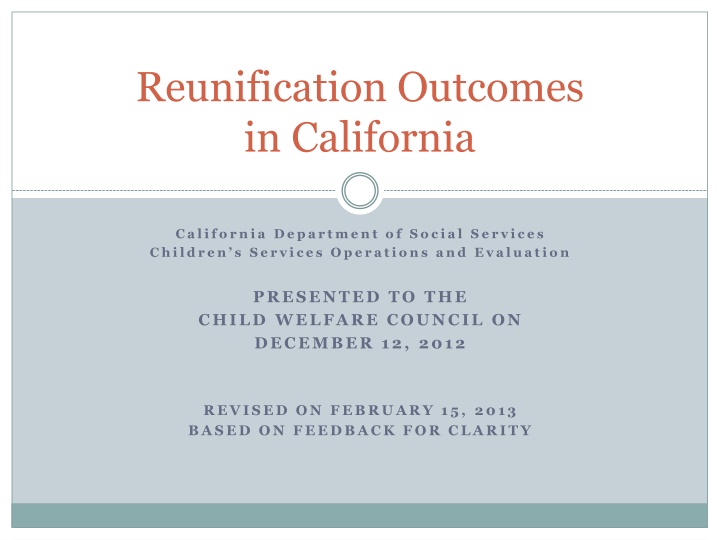
Family Reunification Outcomes in California
Explore data and insights on family reunification outcomes in California's Child Welfare System, including baseline numbers of children served, pathways for reunification, and re-entry rates post-reunification.
Download Presentation

Please find below an Image/Link to download the presentation.
The content on the website is provided AS IS for your information and personal use only. It may not be sold, licensed, or shared on other websites without obtaining consent from the author. If you encounter any issues during the download, it is possible that the publisher has removed the file from their server.
You are allowed to download the files provided on this website for personal or commercial use, subject to the condition that they are used lawfully. All files are the property of their respective owners.
The content on the website is provided AS IS for your information and personal use only. It may not be sold, licensed, or shared on other websites without obtaining consent from the author.
E N D
Presentation Transcript
Reunification Outcomes in California California Department of Social Services Children s Services Operations and Evaluation PRESENTED TO THE CHILD WELFARE COUNCIL ON DECEMBER 12, 2012 REVISED ON FEBRUARY 15, 2013 BASED ON FEEDBACK FOR CLARITY
Goals 2 To provide baseline data on the number of children served in the Family Maintenance service component of the Child Welfare System: The provision of these services both before and/or after being served in Family Reunification service component of the Child Welfare System To provide baseline data on the number of children served in foster care under the Family Reunification service component of the Child Welfare System To understand which populations achieve better reunification outcomes within our current Child Welfare System
Family Reunification Pathways 3 Return home Removal from home Case End Case Start Family Reunification Services Pre-Placement Family Maintenance Post-Placement Family Maintenance Services to prevent removal Services to stabilize families post- reunification to prevent re-entry into foster care Services to promote safe and timely reunification
How many children have families who are receiving Family Reunification Services? 4 July 1, 2012, UCB/CDSS Dynamic Website 1.9% 4.5% 53.7% 46.1% 95.5% 98.0% Pre-Placement (FM) (18,221) Post-Placement (FM) (9,364) Voluntary Family Reunification (24,025) Court Ordered
How soon do children reunify with their families? 5 Of those children who entered foster care for the first time (approximately 23,000) in 2011 and 2010, we can expect that: 26% of children reunified within six months 43% reunified within one year, 62% will reunify within two years, 64% will reunify within three years or more (Multi State Foster Care Data Archive, Chapin Hall).
How many children re-enter care following reunification with their families? 6 Eleven percent of children who reunified with their families in Federal Fiscal Year 2011 re-entered foster care within 12 months. Infants were more likely than any other age group (17%) to re-enter foster care within 12 months following reunification. Children placed in group care (19%) and foster family homes (15%) were more likely to re-enter foster care within 12 months following reunification. Children placed in relative care were least likely to re-enter the system. Infants who entered foster care for the first time and who were placed in foster family homes are at greatest risk of re- entry; nearly 23% experienced a subsequent removal.
Child Welfare Sample 7 31,771 children who have reunified at least once in the last year. 45% of children were receiving services through an open case plan as of November 30, 2012 Age at first case opening: 0 5 years old - 51% 6-10 years: 24% 11-17 years: 25% Gender: 48% female Race: 44% Latino, 30% White, 20% Black, 3% Asian American, 2% American Indian.
What combination of services (via Service Component) did families receive? 8 Return home (31,771) Removal from home Case Start Case End 51% Post-Placement Family Maintenance Family Reunification Pre-Placement Family Maintenance Post-Placement Family Maintenance 23% Family Reunification 15% Family Reunification 9% Family Maintenance
Definitions 9 Successful reunification Cases that resulted in reunification, 50% of the total sample Unsuccessful reunification Reunification was attempted, but parental rights were eventually terminated and children experienced multiple re- entries, 15% of the total sample In Progress Families have an open case plan in Family Reunification or Family Maintenance, 34% of the total sample
Effects of Family Stabilization Services 10 Provision of Post-Placement FM services result in: Fewer re-entries into care Shorter stays in foster care Greater chance of successful reunification: Families who received family reunification services only and did not receive family maintenance services after foster care, 17% unsuccessful reunification Families who received family reunification services and family maintenance services after foster care, 3% unsuccessful reunification
Factors Associated with Successful Reunification 11 Provision of Post-Placement Services Reasons children were placed into foster care: When children were removed due to physical or emotional abuse, the system is more successful in helping parents develop positive parenting skills. The system is less successful in helping parents overcome incapacities or issues (e.g., mental/physical health, substance abuse) that led to neglect or abuse of their children. Demographic characteristics The system is most successful in reunifying Asian America/Pacific Islander families; and least successful in reunifying American Indian families.
